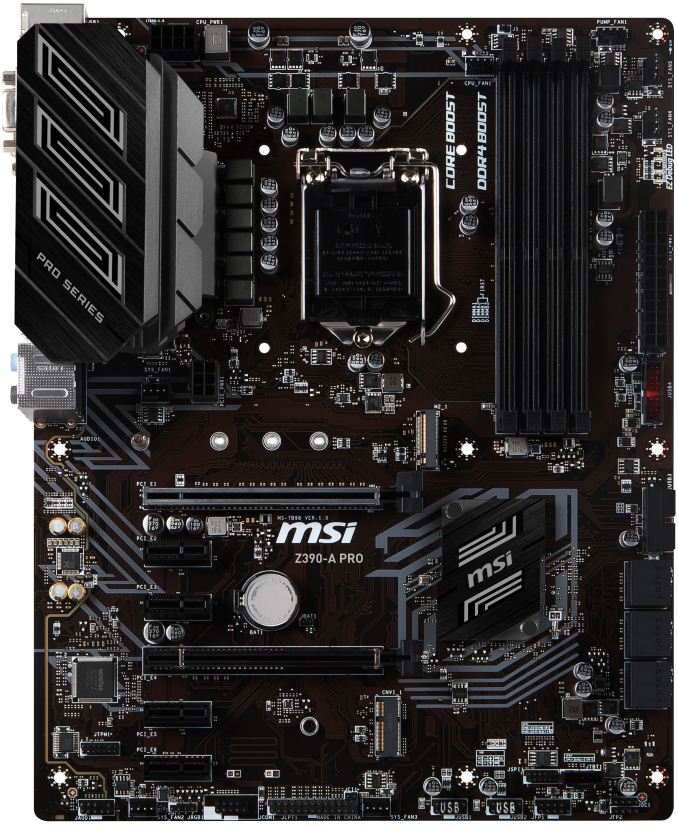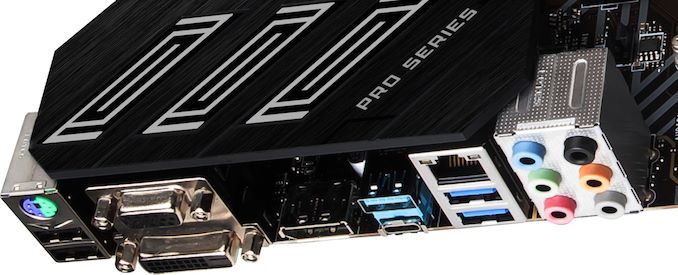Intel Z390 Motherboard Overview: 50+ Motherboards Analyzed
by Ian Cutress & Gavin Bonshor on October 8, 2018 10:53 AM EST- Posted in
- Motherboards
- Intel
- MSI
- Gigabyte
- ASRock
- EVGA
- Asus
- NZXT
- Supermicro
- Z390
MSI Z390-A PRO
The main difference between the MSI Z390-A PRO and the rest of MSI's Z390 product stack is that this board isn't specifically targeted towards gamers. The aesthetics are simple with a coffee colored PCB which does include silver patterning across it; primarily around the edges of the board and around the silver and black heatsinks. The main selling point of the MSI Z390-A PRO is in its value with a good selection of controllers including an Intel I219V Gigabit Ethernet controller and a Realtek ALC892 HD audio codec handling the onboard audio.
On the board are two full-length PCIe 3.0 slots with the top MSI Steel Slot coated slot running at x16 and the second full-length slot operating at x4. Also present is plenty of PCIe 3.0 x1 ports as the Z390-A PRO has four in total. The storage options are pretty basic on the Z390-A PRO with this being the only Z390 MSI board to feature only one PCIe/SATA M.2 slot; this is complemented by a total of six SATA ports with support for RAID 0. 1. 5 and 10 arrays. In terms of memory, the board is packing four RAM slots with support for DDR4--4400 with a maximum capacity of up to 64 GB.
Rear panel connections wise the MSI Z390-A PRO has a USB 3.1 Gen2 Type-A and Type-C port and four USB 2.0 ports; up to two USB 3.0 and four USB 2.0 ports can be made available through the use of internal headers. A total of six 3.5 mm audio jacks are powered by a Realtek ALC892 HD audio codec and a single LAN port controlled by an Intel I219V Gigabit networking chip. The Z390-A PRO is the only MSI board to include a D-Sub video output which seemingly replaces the HDMI and also included is a DisplayPort and DVI-D output.
The MSI Z390-A PRO is the cheapest Z390 motherboard from MSI at launch with a suggested retail price of $140 which all things considered is still quite expensive for chipsets entry-level model. The board makes use of a decent set of controllers which further hikes the price up and it seemingly means users are going to have to look at adding a little more cash to their budget in order to jump onto MSI's Z390 platform; especially compared with the equivalent models when the Z370 chipset debuted.












79 Comments
View All Comments
Smell This - Tuesday, October 9, 2018 - link
Much.Of.
The.
Same.
2 HSIO lanes per Gen 2 port and WiFi. Wow (rolling I-eyeballs) ...
MadAd - Tuesday, October 9, 2018 - link
58 motherboards, only 13 of which are smaller than ATX. When on earth are we going to move off this outdated oversized format? Its just more of the same every time, so depressing.gavbon - Wednesday, October 10, 2018 - link
13 is better than 0, or 12 :DMadAd - Wednesday, October 10, 2018 - link
Considering very small form formats (ITX) are harder to build for and only 7 are uATX, a size which is the most useful to transition away from ATX then no, it feels like an afterthought from a lazy industry. I mean who uses more than 1 main video card and 2-4 sticks of ram in a gaming PC these days? Even water builds into uATX isnt that hard to accomplish.After literally decades ATX should be a choice for edge cases not a mainstream build.
shaolin95 - Monday, October 22, 2018 - link
who cares about midge boards!Edkiefer - Wednesday, October 10, 2018 - link
All these MB with 2x 8 pin power inputs, is both mandatory and if so I guess new PSU will need 2x 8pin now.entity279 - Wednesday, October 10, 2018 - link
so it's ok to just buy SM motherboards now with them being involved in a security scandal?gavbon - Thursday, October 11, 2018 - link
I currently have the Supermicro C9Z390-PGW awaiting to go on the test bench next week, so from a consumers standpoint, I could potentially shed light on that board. As far as the Chinese/Supermicro/Spy scandal goes, I don't want to speculate without the finer details.eastcoast_pete - Wednesday, October 10, 2018 - link
Ian & Gavin, thanks for the overview.@ both - Question: I've read that Intel, to deal with its bad planning/capacity problems on 14 nm, has contracted the fabbing of some of its chipsets out to TSMC, specifically in TSMC's 22 nm tech. Is that correct, and did you have a chance to confirm that the new 390s used by these boards are indeed made by Intel on their 14 nm FinFET tech, or are they made by a contractor (TSMC)?
DanNeely - Wednesday, October 10, 2018 - link
AFAIK the chipsets being reverted to 22nm are using Intel's 22nm process in old unupgraded fabs. Doing so would be far less work than porting to a process from a different company; the latter would require massive rework to follow a completely different set of design rules.